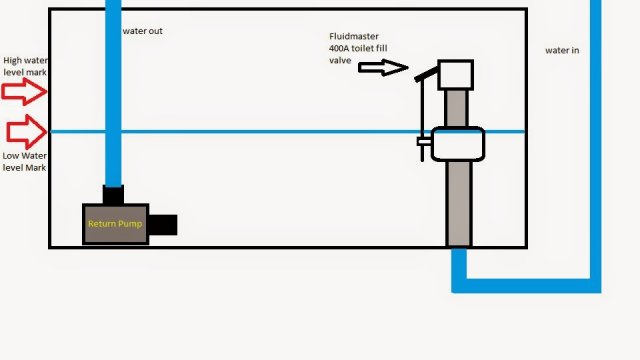Ive been considering adding a sump to my 55g tank. I would like to add some water capacity to the system and be able to hide the filter and heater in the stand below the tank, I have never had a sump in a tank before but i was thinking about the anti siphon hole and power outages and start up. It seems to me(I may be mistaken) but with an anti siphon hole in a set up, when the power goes out you lose the siphon and have to start it back up once the power returns. I was thinking about some kind of valved setup that would eliminate the need for this. Im a plumber and I thought of a toilet fill valve. from what I though of it seems to have several advantages;
1)It works as its own anti siphon setup, when the water gets too high in the sump it would turn off automatically, while leaving all the water in the line so that the siphon can start up on its own once the water level in the sump drops
2)because of how a toilet fill valve works it will shut off at the top of its limit but will not start up again until the water level gets about 2" lower than the start level. From what I have been reading it seems like this could be used to move the water level above and below a bio substrate to get a lot of oxygen to it.
3)it has its own bulkhead built in and a standardized threaded connection for easy hookup.
4)because it is in contact with the domestic water supply of a house it is NSF rated(national sanitation foundation) it probably wont leach anything that will kill fish or us(this would have to be looked into more.)

a couple of issues that I see so far:
1)in order for it to have reliable operation it would need a good filtered input
2)you would need the amount of water siphoned in to the tank to be able to outpace the pump so that you could have the rising and falling water line, aka you might need more than one fill valve and siphon set up, all calibrated to the same fill and stop heights
3) something else that I haven't though of yet.....
I did a Google search of this and found nothing, and a quick look through the forum. I dont know if this has not been thought of or used before or if its been tried and was a failure. Im very interested in the idea, and if anyone has any inputs or ideas i would greatly appreciate them

1)It works as its own anti siphon setup, when the water gets too high in the sump it would turn off automatically, while leaving all the water in the line so that the siphon can start up on its own once the water level in the sump drops
2)because of how a toilet fill valve works it will shut off at the top of its limit but will not start up again until the water level gets about 2" lower than the start level. From what I have been reading it seems like this could be used to move the water level above and below a bio substrate to get a lot of oxygen to it.
3)it has its own bulkhead built in and a standardized threaded connection for easy hookup.
4)because it is in contact with the domestic water supply of a house it is NSF rated(national sanitation foundation) it probably wont leach anything that will kill fish or us(this would have to be looked into more.)

a couple of issues that I see so far:
1)in order for it to have reliable operation it would need a good filtered input
2)you would need the amount of water siphoned in to the tank to be able to outpace the pump so that you could have the rising and falling water line, aka you might need more than one fill valve and siphon set up, all calibrated to the same fill and stop heights
3) something else that I haven't though of yet.....
I did a Google search of this and found nothing, and a quick look through the forum. I dont know if this has not been thought of or used before or if its been tried and was a failure. Im very interested in the idea, and if anyone has any inputs or ideas i would greatly appreciate them






